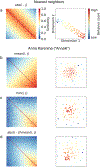Idiosynchrony: From shared responses to individual differences during naturalistic neuroimaging
- PMID: 32276065
- PMCID: PMC7298885
- DOI: 10.1016/j.neuroimage.2020.116828
Idiosynchrony: From shared responses to individual differences during naturalistic neuroimaging
Abstract
Two ongoing movements in human cognitive neuroscience have researchers shifting focus from group-level inferences to characterizing single subjects, and complementing tightly controlled tasks with rich, dynamic paradigms such as movies and stories. Yet relatively little work combines these two, perhaps because traditional analysis approaches for naturalistic imaging data are geared toward detecting shared responses rather than between-subject variability. Here, we review recent work using naturalistic stimuli to study individual differences, and advance a framework for detecting structure in idiosyncratic patterns of brain activity, or "idiosynchrony". Specifically, we outline the emerging technique of inter-subject representational similarity analysis (IS-RSA), including its theoretical motivation and an empirical demonstration of how it recovers brain-behavior relationships during movie watching using data from the Human Connectome Project. We also consider how stimulus choice may affect the individual signal and discuss areas for future research. We argue that naturalistic neuroimaging paradigms have the potential to reveal meaningful individual differences above and beyond those observed during traditional tasks or at rest.
Keywords: Behavior; Individual differences; Inter-subject correlation; Naturalistic; Representational similarity analysis; fMRI.
Published by Elsevier Inc.
Figures





References
-
- Bartolomeo P, Seidel Malkinson T, de Vito S, 2017. Botallo’s error, or the quandaries of the universality assumption. Cortex 86, 176–185. - PubMed
Publication types
MeSH terms
Grants and funding
LinkOut - more resources
Full Text Sources

